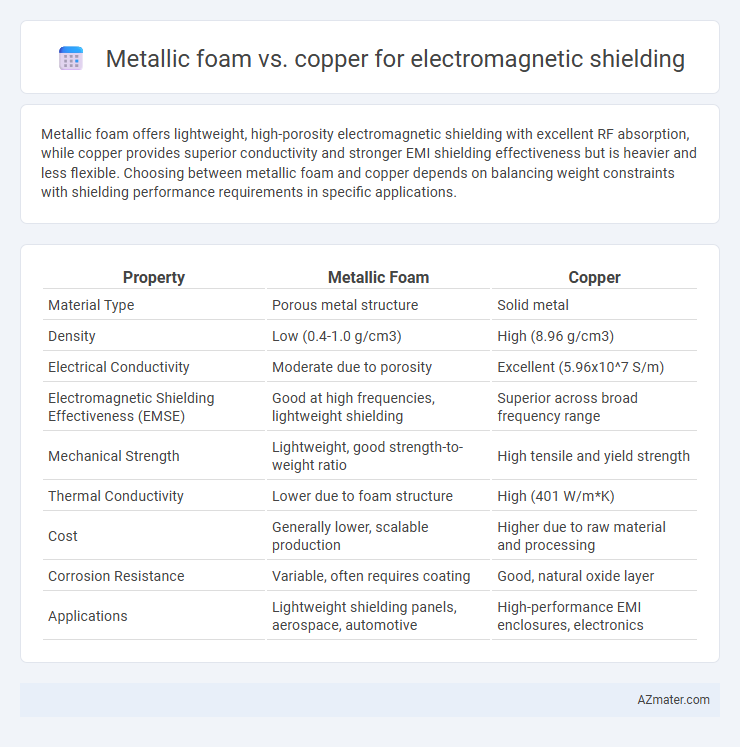Metallic foam offers lightweight, high-porosity electromagnetic shielding with excellent RF absorption, while copper provides superior conductivity and stronger EMI shielding effectiveness but is heavier and less flexible. Choosing between metallic foam and copper depends on balancing weight constraints with shielding performance requirements in specific applications.
Table of Comparison
| Property | Metallic Foam | Copper |
|---|---|---|
| Material Type | Porous metal structure | Solid metal |
| Density | Low (0.4-1.0 g/cm3) | High (8.96 g/cm3) |
| Electrical Conductivity | Moderate due to porosity | Excellent (5.96x10^7 S/m) |
| Electromagnetic Shielding Effectiveness (EMSE) | Good at high frequencies, lightweight shielding | Superior across broad frequency range |
| Mechanical Strength | Lightweight, good strength-to-weight ratio | High tensile and yield strength |
| Thermal Conductivity | Lower due to foam structure | High (401 W/m*K) |
| Cost | Generally lower, scalable production | Higher due to raw material and processing |
| Corrosion Resistance | Variable, often requires coating | Good, natural oxide layer |
| Applications | Lightweight shielding panels, aerospace, automotive | High-performance EMI enclosures, electronics |
Overview of Electromagnetic Shielding
Electromagnetic shielding involves the use of materials that block or attenuate electromagnetic fields, protecting sensitive electronics from interference. Metallic foam offers high surface area and lightweight properties, enhancing absorption and dissipation of electromagnetic waves while maintaining structural integrity. Copper, known for its excellent electrical conductivity and high shielding effectiveness, provides superior reflection of electromagnetic radiation but is heavier and less versatile in form factor compared to metallic foam.
Introduction to Metallic Foams
Metallic foams, characterized by their porous structure and low density, offer significant advantages for electromagnetic shielding due to their high surface area and electrical conductivity. Unlike solid copper, metallic foams provide effective attenuation of electromagnetic interference (EMI) while reducing weight, making them ideal for aerospace and electronics applications. Their unique combination of mechanical strength and electromagnetic damping enhances performance where traditional copper shielding is often too heavy or rigid.
Copper as a Traditional Shielding Material
Copper serves as a traditional electromagnetic shielding material due to its high electrical conductivity and excellent attenuation of electromagnetic interference (EMI). Compared to metallic foam, copper offers superior shielding effectiveness across a wide frequency range, providing robust protection in sensitive electronic applications. Its dense and continuous structure ensures minimal signal leakage, making it a preferred choice for critical environments requiring reliable EMI mitigation.
Electromagnetic Shielding Effectiveness: Metallic Foam vs Copper
Metallic foam offers enhanced electromagnetic shielding effectiveness due to its porous structure, which promotes multiple reflections and absorption of electromagnetic waves, outperforming solid copper in certain high-frequency applications. Copper provides superior conductivity and continuous material coverage, resulting in excellent shielding effectiveness for low to mid-frequency ranges but lacks the lightweight and surface area benefits of metallic foam. Optimal electromagnetic shielding performance depends on frequency range, with metallic foam favored for lightweight, broadband attenuation and copper preferred for dense, highly conductive barriers.
Weight and Structural Considerations
Metallic foam, characterized by its low density and porous structure, offers significant weight reduction compared to solid copper sheets, making it an ideal choice for lightweight electromagnetic shielding applications. Copper provides superior electrical conductivity and mechanical strength but is much heavier and less adaptable to weight-sensitive designs. The open-cell architecture of metallic foam enhances structural resilience while minimizing material usage, balancing performance with weight efficiency in shielding solutions.
Thermal Conductivity Comparison
Metallic foam exhibits lower thermal conductivity compared to solid copper, typically ranging from 10 to 50 W/m*K depending on porosity, whereas copper boasts approximately 401 W/m*K at room temperature. Despite copper's superior heat conduction, metallic foam's porous structure enhances heat dissipation and weight reduction in electromagnetic shielding applications. The trade-off between thermal conductivity and material density makes metallic foam a strategic choice where lightweight properties are essential alongside effective thermal management.
Cost and Manufacturing Factors
Metallic foam offers a lightweight alternative to solid copper for electromagnetic shielding, significantly reducing material costs due to its lower density and less raw metal usage. Manufacturing metallic foam involves processes like powder metallurgy or casting with gas injection, which can be more complex but allow for customizable porosity and thickness to optimize performance and cost-efficiency. Copper, while providing excellent conductivity and shielding effectiveness, incurs higher material costs and requires more energy-intensive manufacturing techniques such as rolling or extrusion, making metallic foam a cost-effective solution for applications where weight and flexibility are crucial.
Design Flexibility and Applications
Metallic foam offers superior design flexibility over copper for electromagnetic shielding due to its lightweight structure and customizable porosity, enabling tailored attenuation across various frequencies. Copper provides excellent conductivity and robust shielding effectiveness but lacks the adaptability in shape and weight reduction that metallic foam achieves, which is critical for aerospace and wearable electronics applications. The porous nature of metallic foam also enhances thermal management, making it ideal for complex geometries in automotive and telecommunications shielding solutions.
Environmental Impact and Sustainability
Metallic foam offers significant environmental advantages over solid copper in electromagnetic shielding due to its reduced material usage and lower weight, resulting in decreased mining and manufacturing energy demands. Copper production involves intensive mining and refining processes that generate substantial greenhouse gas emissions and toxic waste, whereas metallic foam often incorporates recycled metals, enhancing sustainability. The porous structure of metallic foam not only provides effective shielding performance but also promotes recyclability and reduces overall environmental footprint compared to traditional copper shields.
Future Trends in Electromagnetic Shielding Materials
Metallic foam offers lightweight, high surface area structures beneficial for electromagnetic shielding, while copper provides excellent conductivity and durability, making it a benchmark material. Future trends emphasize hybrid composites integrating metallic foams with copper or other conductive materials to enhance shielding effectiveness and mechanical flexibility. Advances in nanostructured coatings and additive manufacturing aim to optimize electromagnetic interference attenuation while reducing weight and cost in next-generation shielding solutions.

Infographic: Metallic foam vs Copper for Electromagnetic shielding
 azmater.com
azmater.com